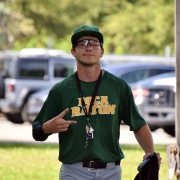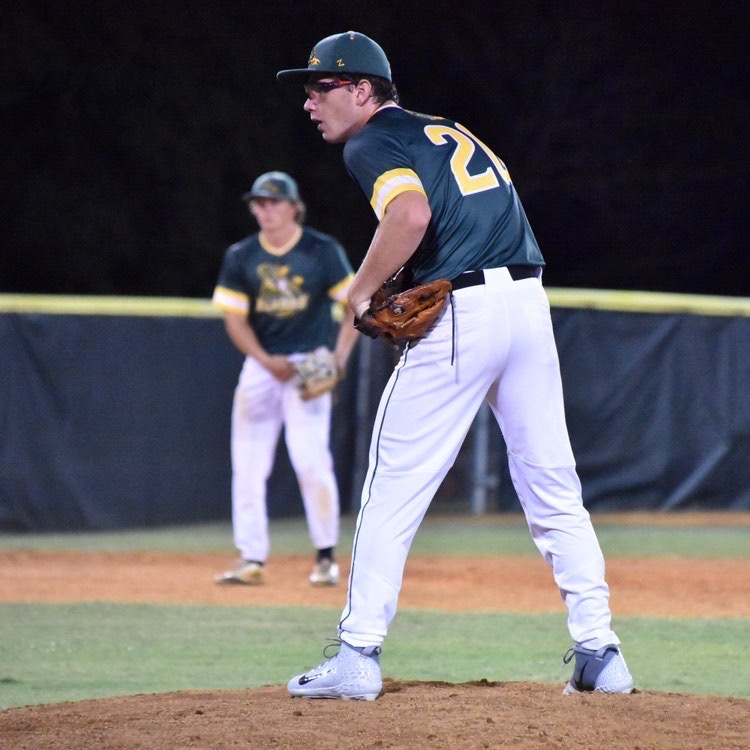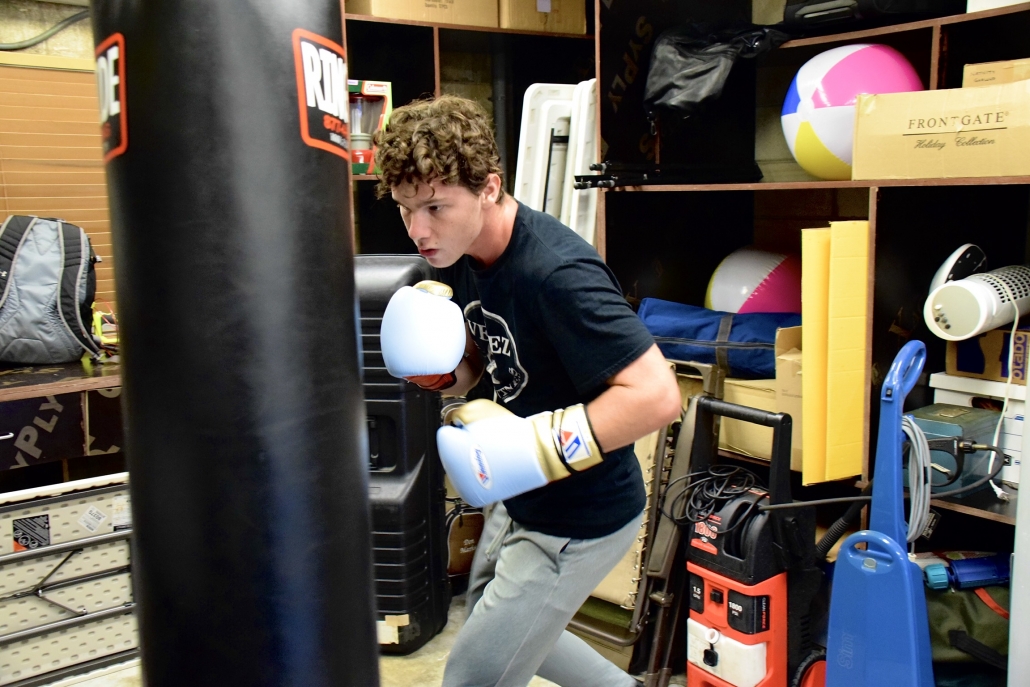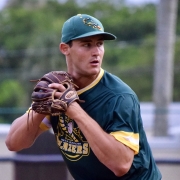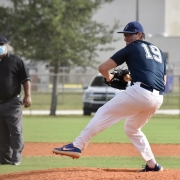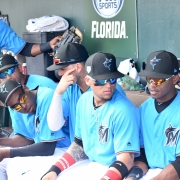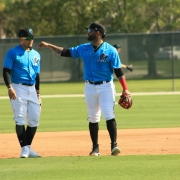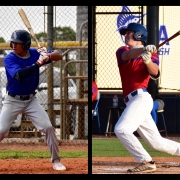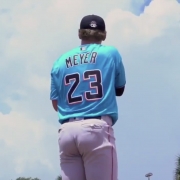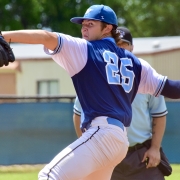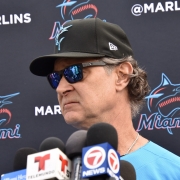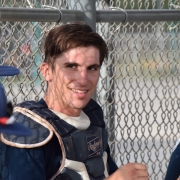Three heart surgeries can’t keep Austin Matsoff off the mound
Austin Matsoff, a sophomore pitcher at MidAmerica Nazarene University in Kansas, has been through three heart surgeries over the last two years. Yet there he was on the mound on June 13 in the South Florida Collegiate Baseball League staring down a hitter from LSU.
Being from a NAIA program, he had no business taking on SEC talent. Which meant he had nothing to lose.
“When I first signed up for the league and I was looking at the rosters from the previous years, my whole mindset was these guys are better hitters than I am pitcher,” Matsoff said. “That’s just proven. They all go to like UCF, Vanderbilt, LSU, all these schools known for baseball and I’m at a small NAIA school in Kansas. So when I came in here, it was really a mindset of what’s the worst that can happen?”
The worst thing never happened. Instead, he struck him out with his submarine delivery.
“That was a big moment for me,” Matsoff said. “It was such a surreal feeling. I never thought of myself being able to be on the same field as these guys like that.”
Clear eyes, full heart, he couldn’t lose. In five appearances so far this summer, Mastoff has allowed only two runs in six innings with three strikeouts and a save.
“I’ve been pitching well all summer and the idea that I’m out here competing with all these other guys is just huge for me.”
MATSOFF’S HEART CONDITION
Austin Matsoff was diagnosed with ventricular tachycardia during his senior year of high school at Westminster Academy in Fort Lauderdale. VT is a condition in which the heart’s lower chambers beat much faster than normal because of a problem with its electrical impulses.
“The main issue with mine is that it beats too fast,” Matsoff said. “It’s a genetic issue. The problem is that there are clusters of electrical nerves attached to it which cause it to beat faster.”
According to Matsoff, the best way he’s been able to treat his heart, ironically, is by making it beat faster. His resting heart rate ranges from 90-120 BPM but when he’s exercising, it ranges between 120-180 BPM, which is actually a normal range when active.
“The problem isn’t when I work out really,” Matsoff said. “It’s when I’m resting that there is a problem. Like I’ll be resting and sometimes it’ll shoot up to 200 BPM.”
Basically his heart is like the bus from “Speed”. He’s got to keep moving or else that’s when tachycardia occurs. It runs in the family. His mother is a triathlete with the same heart issues.
“The way my heart condition works is I actually feel better when I work out,” Matsoff said. “When I work out, my sinus heartbeat rhythm takes over the bad heartbeat and it levels off at 180 BPM. It only gets up to 200+ when I am resting, because that is when the electrical nerves are taking over. So I am always working out because my heart goes into a normal rhythm and makes me feel better as opposed to resting.”
BASEBALL BEFORE AND AFTER SURGERY FOR AUSTIN MATSOFF
Matsoff’s first surgery was in December 26, 2018. The second one came on June 5, 2019, a week after his high school graduation. Both procedures were cardiac ablations whereas the third surgery resulted in a monitor implanted in his chest just above the pulmonary valve of his heart.
The surgeries have not prevented his heart from experiencing tachycardia. His most recent episode came on May 29, just before the start of the summer season.
“I didn’t really feel that one,” Austin Matsoff said. “I didn’t find out about it until I went to a doctor and they checked my monitor.”
His worst case of tachycardia occurred while he was in college a few weeks after the third surgery.
“I was at dinner up in kansas after a practice,” Matsoff said. “I started shaking then felt a sharp pain in my left shoulder and my heart rate got up to 220 BPM.”
A fourth heart surgery has not been scheduled nor has it been recommend.
Matsoff pitched on the JV team as a freshman during the fall at MNU. His two biggest games came the day before his third heart surgery, which happened on October 10, 2019, and week after.
“Pitching before the surgury was probably the most energetic I have ever been on a baseball field,” Austin Matsoff said. “We had a night game against our rival school. It was about 40 degrees, but there were a good amount of people at the game. I knew I was only going out for one inning and it was the best inning I threw all fall. Struck out the last batter of the inning and got super hyped up because I knew there was a chance I wouldn’t be throwing again for a while.
“The game after my surgery was a little scary,” he said. “I had pestered my coach all week to let me throw simply because it was the last game of the fall and I wanted the satisfaction of coming back for our last game to end fall on a high note. During warm ups and running around in the outfield, I was feeling a little uncomfortable because I was not used to having the monitor in my chest. When I got on the mound, I was trying to make adjustments to accommodate my discomfort and it was difficult, but I figured it out and put up a zero for my inning.”
HOW AUSTIN MATSOFF ENDED UP AT MNU
How Austin Mastoff ended up at MidAmerica Nazarene is an amazing story in itself. In high school, he went from only six at-bats in junior varsity as a freshman to hitting .400 while starting every game as a sophomore, finishing with two varsity pinch-hit appearances.
He didn’t begin pitching until at the tail end of the fall semester of his junior season, when his coach decided that he will be a submarine pitcher from here on out. The team had a crowded outfield and his switch to pitcher filled a need on the varsity front.
MNU was the only school to take a chance on Mastoff and give him a scholarship.
WORKING OUT LIKE HIS LIFE DEPENDED ON IT
When he’s not playing baseball, Austin Matsoff hits the gym for olympic weightlifting and boxing. He got hooked on fitness the summer before his senior year of high school. He credits weight lifting for playing a major role in his development.
“One thing in particular I really enjoyed was olympic lifting because it involves strength, speed, and mobility,” Matsoff said. “When I got to MNU, our strength coach was an olympic lifter and she saw me wanting to work and helped me out. She gave me programs and would help coach me whenever I had time in between classes.”
Boxing originally started as a fun way for Matsoff to get in shape. He wasn’t trying to get in a ring and fight but he enjoys the workout immensely. He joined a boxing gym in his college town and saw the sparring in action and his competitive nature took over.
“Before I knew it, I was getting in the ring and sparring on a daily basis,” Matsoff said. “It has been one of the greatest stress releases that I’ve ever experienced other than baseball. The problem with baseball, especially as a pitcher, if you throw too much you risk injury. So as much of a release as baseball is to me, I can only do it so much before I risk hurting my arm or something like that. Boxing is something I can do that gets me in better shape for baseball without risking my arm.”
Matsoff has a garage gym complete with a speed bag and a heavy bag. He also has gym access to through SFCBL, which has a good amount of space and allows him to do keep up his weightlifting.
Between working out eight hours a day and playing baseball against Division I competition in his backyard, Austin Mastoff says, “This is the best I have felt in a long time.”
